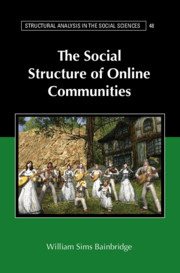Book contents
- The Social Structure of Online Communities
- Structural Analysis in the Social Sciences
- The Social Structure of Online Communities
- Copyright page
- Contents
- Preface
- 1 Introduction
- 2 Facebook
- 3 Virtual Worlds
- 4 Open-Source Software
- 5 Wikis
- 6 Citizen Social Science
- 7 Digital Government
- 8 Cultural Science
- Notes
- Index
- Series page
7 - Digital Government
Published online by Cambridge University Press: 06 March 2020
- The Social Structure of Online Communities
- Structural Analysis in the Social Sciences
- The Social Structure of Online Communities
- Copyright page
- Contents
- Preface
- 1 Introduction
- 2 Facebook
- 3 Virtual Worlds
- 4 Open-Source Software
- 5 Wikis
- 6 Citizen Social Science
- 7 Digital Government
- 8 Cultural Science
- Notes
- Index
- Series page
Summary
As modern information and communications technologies emerged, something resembling a social movement arose that not merely sought to use them to improve the efficiency and effectiveness of traditional government, but also as a vehicle for hopes to transform governance. The common term for the movement, digital government, can be interpreted in different ways, including as a potentially tyrannical increase in the power of government over its citizens, but it was usually presented as a set of tools through which democratic governments could serve their citizens better.
- Type
- Chapter
- Information
- The Social Structure of Online Communities , pp. 204 - 240Publisher: Cambridge University PressPrint publication year: 2020

